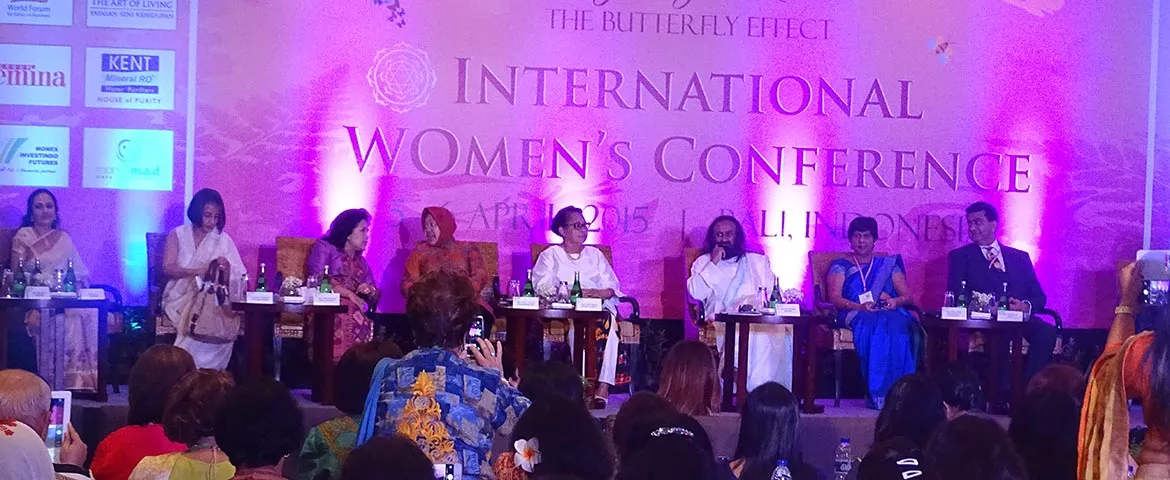Excerpts from the Speech of Ms Hema Hari Conceptualizer and Founder of Bharath Gyan.
Jai Gurudev. Om Shanti Om. Swastirastu. I would like to thank Bhanu didi for inviting us and giving us this opportunity to share these nuggets of information that we have been finding about our ancient civilization and the practices of our ancestors, their ethos, and their values.
So, it can guide us for the next few millennia and we would like to share it with everyone across the world so that as a whole, we can move forward as one global family, as Guruji says Vasudaiva Kutumbakam. So, coming to the Vedas. You know we were talking about the word patanga. The word patanga comes from pat which means, a flag, which is a flat piece of cloth. So butterflies’ wings are like a flat piece of cloth. So a butterfly is called a patanga and if you look at it, there was one of the slokas in the Vedas which is called the Maya bheda sloka and this is attributed to a Rishi called Patanga Maharshi and this sloka is actually a sloka which is meant to be recited when they are performing a ritual and an offering to the sun. We are in a land of Gods and in a land of rituals, Bali, and I don’t think there could be a better place to explain the sloka than this particular land. This is an offering hymn which is sung when they make an offering to the sun.
I will briefly read the translation of the three shlokas. The first shloka is, the butterfly anointed with the maya of the asura can be seen by wise ears with their minds and heart. These enlightened can then see clearly the radiance of that which rises forth from within the ocean breaking through its being in all the directions it desires. So that’s the first shloka. We will see how. This is the exact translation. The actual meaning we will see subsequently. Let’s go through the three shlokas. The butterfly that is the sun, where in its mind, the wak, which is the gandharva, in its boom, is singing soundlessly. That brilliant, once resounding mind of the wise, literally drink in at this enlightening juncture. The never resting sun is seen moving between the northern and the southern halves coming near and going beyond journeying in its path, continually revolving.
U know, u may be wondering as to why am i wanting to explain this maya bedha shloka and what does it have to do with us and the environment. How does it have any relevance to this conference at all? The next slide should tell you. This is the pictorial representation of this maya. Very complex maya bheda shloka. The sun has been. This rishi is equating the sun to a patanga, so he says the sun is like a butterfly in the sky, a flat disc which is splitting and going across the sky, in movement across the sky, it flies across the sky. And this rishi, the seer, who is sitting and making the offering to the sun, is saying this in mind, and you know that he says that the sun represents the magic of nature. The maya is magic, the illusion. The maya asura, our engineer par excellence, lived about at least 5000 years ago. And there are people living even today in India who are traditionally architects/engineers by profession, and these are the people who, in bygone days, have built the beautiful cities of Ayodhya, of Dwaraka, of Srilanka- i mean of Lanka of Ravana. So these are the people who had built and these asuras had the magical power to create this illusion of a sun whose white light, as it emerges, actually contains the seven colors which we don’t see normally. It is only when you pass it through a prism that you get to see the seven colors, which are like the wings of the butterfly. But so is true for the rishi, who has sharpened his mind like a prism. He is able to discern and separate out the seven colors from this single color and see the magic in nature. At the same time, when he is doing this performance, when he is making this offering, if he can unite himself with the nature, he will also be able to listen to the soundless song that is there in nature, which is represented as the song of the sun. And he calls it the song of the gandharva because gandharvas are semi divine beings whose who represent beauty art, music, dance. But these are not things that can be discerned by human ear. So he says that, if you unite yourself and your consciousness with the nature, then you can listen to this beautiful song of nature. So on one side he is talking about seeing the diversity and the different colors, and on the other side he is talking about uniting and listening to the soundless music of the sun. But what is this soundless music? It is nothing but the rhythm in nature. The song is being sung to the beats of nature. The term ‘rhythm’, in an ancient Indian language was called, rhytha. That is the source for the word rhythm and what is this rhytha all about? The sun coming and going. The day, the rotations, the revolutions, all that is happening in the cosmos, which gives you the days, the nights, the seasons, the suns traversal from the tropic from one end to the other, that what do you call the movement of the axis of the sun, which is why you have your global warming and your ice ages, all of these are to do with the movement in the cosmos, which are all rhythmic, which are all cyclic. And the rishi who is uttering the shloka, when he is doing the homa and offering to the sun, if he realizes this as he makes his offering , he drinks in all this enlightenment, all this information, all this knowledge about the sun and unites himself with nature. Similarly, this maya beda shloka, these three verses have lot of relevance to us as well. If we can understand the importance of this, then we will see and know how the whole nature is nothing. What is environment? It is nothing but the nature around us. And if we can listen to the music of this nature, and be in unison with this, then there would really be no conflict, there would really be no crisis situation. For one thing now, you know it, because of this shloka. Also one really wonders whether it is because of the butterfly, the patanga, that this rishi got his name as rishi patanga, or because it was sung by rishi patanga, that the butterfly got its name patanga!
So it is little wonder; i mean look at the significance that they have attached to the butterfly and its little wonder that you know it’s associated with this, a kind of a chain reaction. But unfortunately the scientists have been talking about this butterfly effect only in connection with disasters. They say how even the smallest change can trigger the largest disaster! But fortunately we have people like Guruji, and bhanu didi here, who were talking about, how you can look at this in a positive way. How the smallest change, a positive change can also magnify and become a larger change and the reason we need to do this is to know that even in your body, a small illness if neglected can lead to a much larger disease. The reason why we need to look into this particular information. All this rhythm in nature we talking about- the nature and environment. We can’t forget that this environment is continuously changing and we need to understand this music of environment. We need to live and dance to this rhythm of environment. You cannot do in summer, what you do in winter, you cannot eat in summer, what you have to eat in winter, so the whole issue of this globalization is we are eating different foods all through the year, we are, you know, continuously living in A/C even during winter. All of this is what is leading to a lot of other problems as well, which has been called as the ‘butterfly effect’ from a disaster point of view. But if you look at it, if you can keep changing continuously with the environment and look at this change as a celebration rather than as a revolution, then you can really make this into a positive effect. It can cascade and snowball into a positive effect. And the difference! There is a beautiful difference between these the two words, ‘reformation’ and ‘transformation’.
Reformation is something where you are focusing on something wrong and trying to bring about a change to correct it, whereas transformation is something where you are focusing on something that is correct and trying to bring about a change to move in that direction. And so just like this butterfly, which starts as a caterpillar, and willingly accepts the metamorphosis process and undergoes the transformation to become the butterfly in itself, giving joy to others, and also is a joy to watch; such a kind of transformation we need to adapt to, when we are handling with elements of the environment. We need to understand, dance to the tune of this environment and this is why a butterfly bears a lot of significance and I really appreciate didi for having chosen this theme, butterfly, as butterflies and bees go together, naturally , and it really has a lot of significance bearing on the environment. I would just like to end by saying that how this butterfly is a tribute, it’s a symbol of the colorful sun in the sky. It is the symbol of the carrier of knowledge across generations. The simple being of the butterfly is the symbol for eternal and transmigrating soul and the consciousness in the universe. It is the symbol of the magical beauty that you can find in nature, the maya. It is the symbol of the soundless sublime music of the gandharva. It is actually dancing to its own music, something that we are not able to hear, splitting and floating in the sky very happily to its own music. It is the symbol of the rhythmic beats of the rhytha, the cosmic order. If every time we see a butterfly, we can remember the maya bedha shloka, we will immediately connect to the cosmic order and the cosmic rhythm. It’s the symbol of the evolving environment which itself is continuously under a metamorphosis, adjusting itself to order of motion in the universe. And finally, it’s a symbol of how we have to adapt to transformation, both, with experiencing joy ourselves so that we can end up giving joy to everybody around. Thank you so much. Thank you everyone.



















